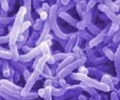Scientists at Sandia National Laboratories have come up with a far more effective way to decontaminate water.
By substituting a single atom in a molecule widely used to purify water, they have created a material, which removes viral, bacterial and other organic and inorganic contaminants from river water destined for human consumption and from wastewater treatment plants, and has a shelf life superior to other products currently on the market."Human consumption of 'challenged' water is increasing worldwide as preferred supplies become more scarce. Technological advances like this may help solve problems faced by water treatment facilities in both developed and developing countries," said Sandia principal investigator May Nyman.
Sandia has applied for a patent for the technology and is working with a major producer of water treatment chemicals to commercialize the product.
The new water treatment reagent, known as a coagulant, is made by substituting an atom of gallium into the center of an aluminum oxide cluster, a commonly used coagulant in water purification.
The substitution isn't performed atom by atom using nanoscopic tweezers but rather uses a simple chemical process of dissolving aluminum salts in water, gallium salts into a sodium hydroxide solution and then slowly adding the sodium hydroxide solution to the aluminum solution while heating.
"The substitution of a single gallium atom in that compound makes a big difference. It greatly improves the stability and effectiveness of the reagent. We've done side-by-side tests with a variety of commercially available products. For almost every case, ours performs best under a wide range of conditions," said Nyman.
Advertisement
The new material also resists converting to larger, less-reactive aggregates before it is used. This means it maintains a longer shelf life, avoiding the problem faced by related commercially available products that aggregate over time.
Advertisement
The study was published in June 2009 in the journal Environmental Science and Technology.
Source-ANI
LIN












